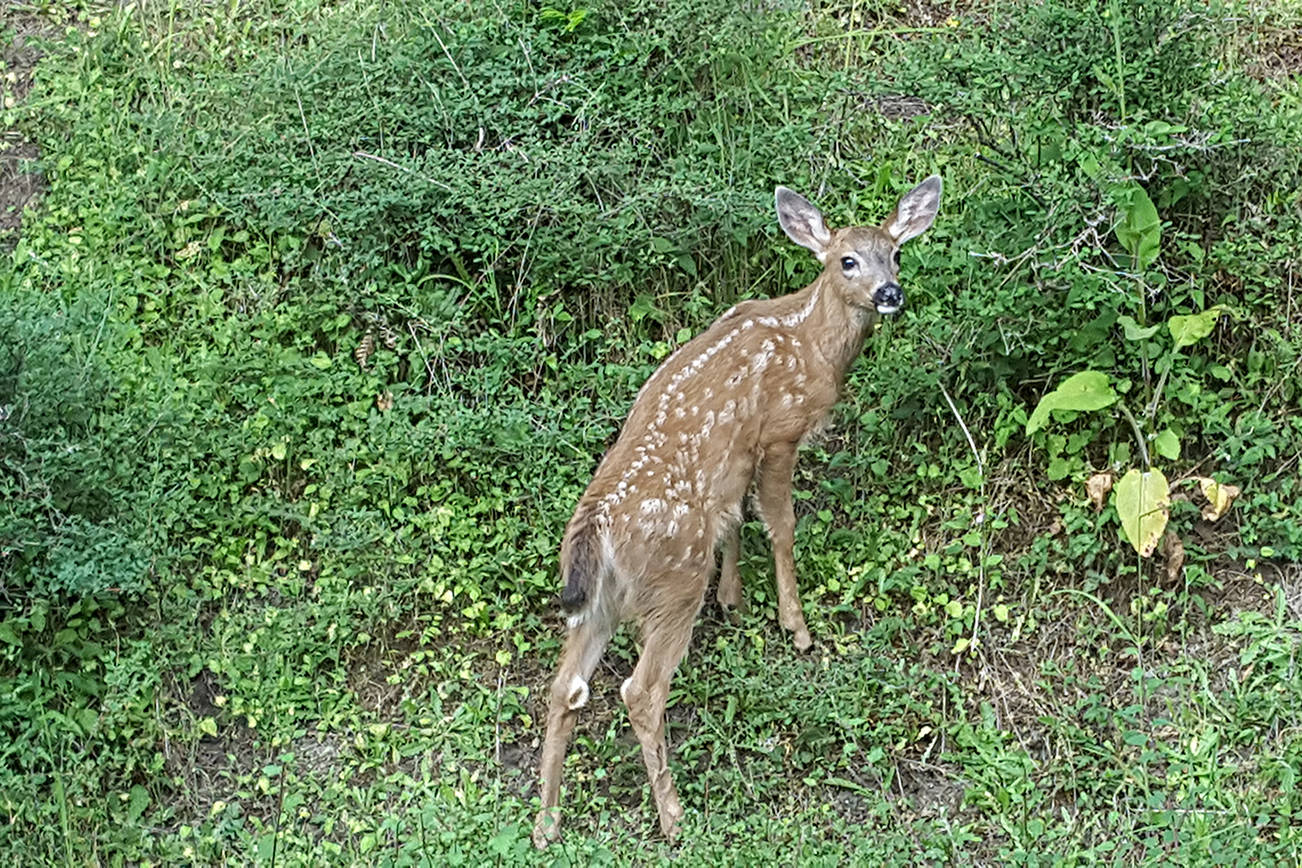If you’re familiar at all with the San Juan Islands, you’re aware that there is no lack of small black-tail deer bounding around, or standing dangerously close to the side of the road.
Ruth Milner, a wildlife biologist for the Washington Department of Fish and Wildlife, held a discussion on the topic with a room of approximately 30 people at the Emmanuel Parish Hall on Wednesday, Sept. 20. The gathering was sponsored by WDFW and SeaDoc Society.
“So a lot of you guys are like, ‘Why is SeaDoc Society helping put a talk on about deer?’” said SeaDoc Society Science Director Joe Gaydos. “We thought, ‘you know what? Let’s just have a public dialogue (about the deer) … We’re not really here to talk about what we’re going to do. We’re just here to educate people and have a public discussion.”
The event began with a clip of an October 2012 lecture titled, “Indirect Effects of Humans on Native Species and Ecosystems,” given by Dr. Peter Arcese, a professor in the Forest and Conservation Sciences Department at the University of British Columbia.
Afterward, the discussion started.
“I want to take time and invite you to have a conversation this evening. But before we start asking questions and providing ideas, I thought I’d give you some basic information so we’re all starting out on the same page.”
In the decades since settlers eliminated the predator population to help protect livestock, the deer population has grown an estimated 10 times larger than it was then.
Milner explained that black-tailed deer generally form familial groups, have a small homerange and are non-migratory.
“As we know, the populations in the islands are very high…. In the San Juans, on Orcas Island, deer are native. They belong here,” said Milner. “Prior to the arrival of white settlers into these communities their populations were controlled by predators.”
Cougars, wolves and bears once provided a balance to the deer, but by the late 1800s, predators no longer roamed the archipelago.
“This was not unique to the islands, this was very typical in the American West. Predators were competition to livestock so they were removed,” said Milner. “With the removal of these predators we’ve seen the deer population increase for the last 100-plus years.”
A very common question Milner said she gets is ‘just how many deer are in the San Juan Islands?’
“We know that populations here are very high. But specific estimates for the islands do not exist,” said Milner. “There is no agreed-upon good census technique for black-tailed deer anywhere in Washington or Oregon.”
Dr. Eric Long, a professor at Seattle Pacific University, estimates there are between 650 and 670 deer on Blakely Island, said Milner.
The lack of understory foliage is indicative of a deer-populated forest, said Milner. An untouched forest in the islands has thick greenery lining the ground. The abundance of deer has resulted in a depletion of available nourishment for the deer, leaving the population nutritionally deprived. Because of this, the island deer are smaller than their mainland counterparts, grow slowly and have little fat on them. Additionally, there are fewer twins born to island deer, and the mortality rate for twins is about 50 percent.
WDFW regulates hunting in the state, and hunting as a means of population control is usually the first thought that humans have.
“When it comes to hunting there are lots of different values,” said Milner. “In my world, I deal with people with all of these values and opinions.”
While some people view deer as akin to their family pets, others see them as a menace to society. Because of these variant feelings about deer, a consensus on how to control their over-population is highly debated.
One reason the state doesn’t allow unlimited hunting by a landowner on their own land is because legally, deer are public property regardless of where they may be standing. Still, there are options for landowners plagued by rampant deer invasion.
For agriculture producers, the state provides a few depredation tags to a landowner so that they may “guard” their produce from deer consumption. Additionally, island hunters are granted a second tag allowing them to shoot a doe after having bagged their first doe or buck with a regular tag.
“We have this second tag in the islands because we’re trying to make some population reductions out here,” said Milner.
Between 2011 and 2016, the hunter population statewide dropped by 2.2 million people, said Milner.
In 2016, San Juan County had 74 applicants for 40 firearm hunting permits; 40 applicants for 25 archery tags; and nine applicants for 20 available muzzleloader tags. Hunting with a rifle is not allowed in the islands.
“Nobody can hunt any animal in the San Juan Islands with a rifle,” said Milner. “This is because we recognize that these are small places and there’s a safety risk.”
WDFW offers up to $1,000 to private landowners willing to allow hunting on their land by the public.
“So far in the islands, no one has taken us up on this,” said Milner. “Why can’t we get people to sign up for this program in the islands?”
Milner added that people fear the opinion of their neighbors, for the safety of themselves and others and – more often than not – they have a general distrust of off-island hunters. Even if more private landowners allow hunting access on their property, Milner doesn’t see that being a permanent solution to the overpopulation problem.
“I just cannot find enough places for enough people to go to kill enough deer to make a difference,” she said. “I’m not 100 percent convinced we could ever reduce the population with hunting as a tool alone. Because we can’t get enough people out on the landscape to kill enough deer we’re not ever going to reduce the population with hunting. We’re never going to reduce it, probably, totally all over the island. Don’t really know because we’ve never really tried.”



